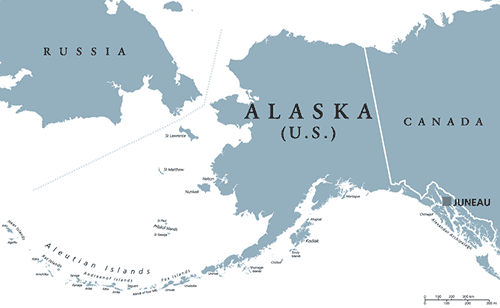After Ukraine, the Bering Strait?
Published on 10/26/2022
Thematics :
After Ukraine, the Bering Strait?
Published on 10/26/2022
Will Alaska become the new territory claimed by the Russians and a zone for direct conflict between the United States and Russia? Edgar Bellow and Lotfi Hamzi, professors of strategy at NEOMA, offer us their geopolitical analysis.
On 6 July 2022, Viatcheslav Volodine, Chairman of Duma, the lower chamber of Russian Parliament, threatened to retake the state of Alaska if the United States seizes or freezes their foreign assets. Viatcheslav told the U.S. to “think” before seizing or freezing Russian foreign assets, “because we also have something we can take.” Many years have gone by since the idea of a Russian Alaska was brought up in the media. This territory was formerly part of the Russian Empire before it was sold to the United States in 1867.
When Russia, against the backdrop of its war with Ukraine, threatens the United States to take Alaska back, one wonders if it’s a real desire or a provocation, brandished to arouse the patriotism and excite the nationalist desires in the Russian population.
After this declaration by the Chairman of Duma, a real campaign called “Alaska is ours” was created on Russian social media. Billboards printed with the same slogan were even put up in the Siberian city of Krasnoyarsk.
It’s not the first time that Moscow has ostensibly shared its desire to see the Russian flag fly over the largest American state. For dozens of years, the subject is regularly brought up in the Russian media. In March 2022, it was Oleg Matveychev, member of Duma and communications advisor to Vladimir Putin, who demanded that the U.S. “return all Russian properties, those of the Russian Empire, the Soviet Union and current Russia.” Alaska as well as the Arctic, which he claimed was “discovered” by Russia.
To be in a greater state of readiness near the conflict zone, Putin sent an expedition to plant the Russian flag at the bottom of the Arctic Ocean on 3 August 2007, asserting its sovereignty over this part of the territory, which is rich in oil reserves. But other countries also covet this region. The United States, Canada, Norway and the European Union by way of Denmark also want to plant their flags. Currently, Russia has restored all of its military bases around the Arctic, equipped them with ballistic missiles and regularly conducts military manoeuvres.

The Bering Strait will either be a zone for conflict and war or a zone for peace and prosperity for the United States, Russia and the rest of the world.
Could the rise of Russian nationalism push it to make a foolish claim that would lead the world into a new high-intensity or nuclear war?
For a zone of mutual prosperity!
An invitation to the United States and Europeans for regional mutual prosperity with Russia could lead to regional and global peace.
The projects already exist and were started in the 1980s during the Cold War with the idea of a motorway and tunnel connecting the two countries via the Bering Strait, which would allow trains to travel through the tunnel and cars to pass over a bridge.
A world tour with a passage across the Bering Strat would become a tourist’s dream. Maritime navigation through the Arctic during the summer would shorten the distances travelled by container ships from Asia to Europe, and likewise distance to the Americas could be reduced with a railway that would connect Russia, the Americas and Europe by way of Alaska.
Will Putin’s Russia want this mutual prosperity with the “decadent” west? Will Russian nationalists abandon their hatred of the U.S. for this mutual prosperity?
Only a regional economy can definitively bind Russia to the U.S. and the rest of the world. The Bering Strait would be the definitive project that would change Russia’s view about its possible isolation from the U.S. and unilateral domination of the world. By using the Bering Strait and Alaska, a peace and prosperity strategy could be definitively developed between the United States, Russia, Canada and the European Union.
Alaska has been inhabited since the end of the last Ice Age, nearly 15,000 years ago. Its discovery is attributed to Vitus Bering, a Danish sailor working for the Russian Empire in 1741. It was only forty years later that the Russians established their first colonies and took full possession of the region. At the end of the 18th century, the business of the Russian-American Company, specialising in the fur trade, was widespread. The Russian Empire expanded to the south in the search for fertile land and even opened an outpost in California, Fort Ross, near San Francisco. At the end of the 19th century, the company’s profits declined. Facing financial hardship and the fear of seeing Alaska fall into the hands of their rival, England, Czar Alexander II sold his North American territories to the United States in 1867 for the amount of seven million dollars. Before the sale of the land, it has been estimated that around 2,500 Russians lived there.

